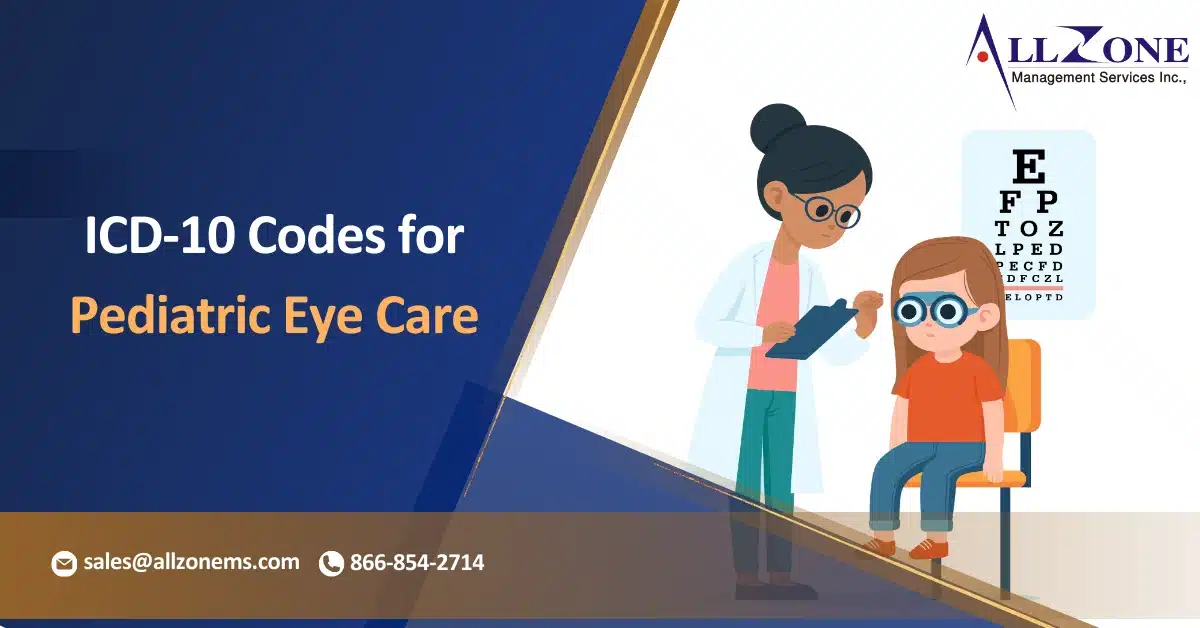Accurate ICD-10-CM coding for Pediatric Eye Care becomes straightforward when you know what to look for. With Children’s Eye Health and Safety Month as a timely reminder, it’s an excellent opportunity for pediatric providers to review common eye-related diagnoses seen during vision exams.
Here, we’ll guide you through three commonly encountered scenarios in pediatric eye care and their appropriate codes.
Vision Screenings: Watch for Abnormal Findings
Children frequently undergo basic vision screenings, often required for school. For these screenings, the following ICD-10-CM Z codes are essential:
-
- Z01.00: Encounter for examination of eyes and vision without abnormal findings
- Z01.01: Encounter for examination of eyes and vision with abnormal findings
- Z01.020: Encounter for examination of eyes and vision following failed vision screening without abnormal findings
- Z01.021: Encounter for examination of eyes and vision following failed vision screening with abnormal findings
ICD-10-CM introduced Z01.020 and Z01.021 to specify visits following a failed vision screening. These six-character codes justify further vision or hearing testing, aligning with Z01.1x codes for ear and hearing exams.
Example Scenario: A pediatric patient visits after failing a school vision screening. The provider finds no issues with the child’s vision or eye health.
Coding: Report Z01.020, indicating a follow-up exam after a failed vision screening without abnormal findings.
Conjunctivitis: Distinguish Between Viral and Non-Viral Types
In Pediatric Eye Care Coding, accurate diagnosis is paramount. Conjunctivitis, or pink eye, is prevalent among children and varies significantly by causes—viral, bacterial, or allergic. Specific documentation is critical to assigning the correct diagnosis code.
Key Viral Conjunctivitis Codes (Category B30):
-
- B30.0: Keratoconjunctivitis due to adenovirus
- B30.1: Conjunctivitis due to adenovirus
- B30.2: Viral pharyngoconjunctivitis
- B30.3: Acute epidemic hemorrhagic conjunctivitis
- B30.8: Other viral conjunctivitis
Key Bacterial/Allergic Conjunctivitis Codes (Category H10):
-
- H10.01: Acute follicular conjunctivitis
- H10.1x: Acute atopic conjunctivitis
- H10.4x: Chronic conjunctivitis
Steps for Accurate Coding:
-
- Determine acute vs. chronic: Ensure the provider documents whether the conjunctivitis is acute or chronic.
- Identify follicular vs. papillary: Check for characteristics like nodules (follicular) or papillae (papillary) in the provider’s notes.
- Specify the affected eye: Use a fifth or sixth character to indicate the eye (e.g., right, left, bilateral, or unspecified).
Example: Acute follicular conjunctivitis of the right eye is coded as H10.011.
Is Inaccurate Coding Hurting Your Revenue Cycle? |
Corneal Abrasions: Accurate Coding for Injuries
Active children are prone to eye injuries, such as corneal abrasions. These are coded under S codes in ICD-10-CM, based on location and encounter type (initial, subsequent, or sequela).
Key Codes for Corneal Abrasions Without Foreign Body:
-
- S05.00XA: Unspecified eye, initial encounter
- S05.01XA: Right eye, initial encounter
- S05.02XA: Left eye, initial encounter
Example Scenario: A 13-year-old patient presents with redness, pain, and blurred vision in the right eye after mowing the lawn. The physician diagnoses a corneal abrasion.
Coding: Report S05.01XA, indicating an initial encounter for a corneal abrasion in the right eye.
Here are some common ICD-10-CM codes used in pediatric eye care:
-
- H53.0: Myopia
- H53.1: Hyperopia
- H53.2: Astigmatism
- H53.3: Presbyopia
- H53.4: Amblyopia (lazy eye)
- H53.5: Strabismus (crossed eyes)
- H53.6: Other refractive errors
- H53.7: Accommodation disorders
- H53.8: Other specified disorders of refraction
- H53.9: Disorder of refraction, unspecified
- H54.0: Cataract
- H54.1: Glaucoma
- H54.2: Macular degeneration
- H54.3: Retinal detachment
- H54.4: Diabetic retinopathy
- H54.5: Other disorders of retina and choroid
- H54.6: Disorders of vitreous body
- H54.7: Disorders of optic nerve
- H54.8: Other disorders of eye
- H54.9: Disorder of eye, unspecified
- H57.0: Injury of cornea
- H57.1: Injury of conjunctiva
- H57.2: Injury of iris
- H57.3: Injury of lens
- H57.4: Injury of uvea
- H57.5: Injury of retina
- H57.6: Injury of optic nerve
- H57.7: Injury of orbit
- H57.8: Other injuries of eye and adnexa
- H57.9: Injury of eye and adnexa, unspecified
- H66.0: Congenital cataract
- H66.1: Congenital glaucoma
- H66.2: Congenital ptosis
- H66.3: Other congenital malformations of eye and adnexa
- H66.4: Albinism
- H66.5: Color blindness
- H66.6: Nystagmus
- H66.8: Other congenital anomalies of eye and adnexa
- H66.9: Congenital anomaly of eye and adnexa, unspecified
Pediatric Eye Care Coding Services in the USA – Allzone Management Services
Navigating the intricate landscape of Pediatric Eye Care Coding requires specialized expertise. At Allzone Management Services, we offer comprehensive coding solutions tailored to meet the unique needs of healthcare providers across the USA.
Benefits of Outsourcing Pediatric Eye Care Coding to Allzone
-
- Increased Accuracy: Minimized coding errors reduce claim rejections and denials.
- Improved Revenue: Maximize reimbursements with precise coding and proper documentation.
- Cost Efficiency: Save on overhead expenses by outsourcing to a reliable partner.
- Compliance Guarantee: Stay aligned with HIPAA, HITECH, and other regulatory standards.
Partner with Allzone for Coding Excellence
With over a decade of experience in the medical billing and coding industry, Allzone Management Services is committed to supporting pediatric eye care providers with top-notch coding solutions. Let us handle the complexities of coding so you can focus on delivering exceptional care to your young patients.
Final Takeaway:
Accurate ICD-10-CM coding in Pediatric Eye Care relies on precise documentation. Whether handling vision screenings, conjunctivitis, or injuries, ensure the provider’s notes include the necessary specifics to assign the correct code. By refining your approach, you’ll enhance coding accuracy, justify medical necessity, and support optimal reimbursement.
|


